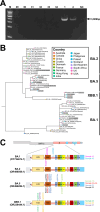Generation of recombinant viruses directly from clinical specimens of COVID-19 patients
- PMID: 38874339
- PMCID: PMC11250110
- DOI: 10.1128/jcm.00042-24
Generation of recombinant viruses directly from clinical specimens of COVID-19 patients
Abstract
Rapid characterization of the causative agent(s) during a disease outbreak can aid in the implementation of effective control measures. However, isolation of the agent(s) from crude clinical samples can be challenging and time-consuming, hindering the establishment of countermeasures. In the present study, we used saliva specimens collected for the diagnosis of SARS-CoV-2-a good example of a practical target-and attempted to characterize the virus within the specimens without virus isolation. Thirty-four saliva samples from coronavirus disease 2019 patients were used to extract RNA and synthesize DNA amplicons by PCR. New primer sets were designed to generate DNA amplicons of the full-length spike (S) gene for subsequent use in a circular polymerase extension reaction (CPER), a simple method for deriving recombinant viral genomes. According to the S sequence, four clinical specimens were classified as BA. 1, BA.2, BA.5, and XBB.1 and were used for the de novo generation of recombinant viruses carrying the entire S gene. Additionally, chimeric viruses carrying the gene encoding GFP were generated to evaluate viral propagation using a plate reader. We successfully used the RNA purified directly from clinical saliva samples to generate chimeric viruses carrying the entire S gene by our updated CPER method. The chimeric viruses exhibited robust replication in cell cultures with similar properties. Using the recombinant GFP viruses, we also successfully characterized the efficacy of the licensed antiviral AZD7442. Our proof-of-concept demonstrates the novel utility of CPER to allow rapid characterization of viruses from clinical specimens.
Importance: Characterization of the causative agent(s) for infectious diseases helps in implementing effective control measurements, especially in outbreaks. However, the isolation of the agent(s) from clinical specimens is often challenging and time-consuming. In this study, saliva samples from coronavirus disease 2019 patients were directly subjected to purifying viral RNA, synthesizing DNA amplicons for sequencing, and generating recombinant viruses. Utilizing an updated circular polymerase extension reaction method, we successfully generated chimeric SARS-CoV-2 viruses with sufficient in vitro replication capacity and antigenicity. Thus, the recombinant viruses generated in this study were applicable for evaluating the antivirals. Collectively, our developed method facilitates rapid characterization of specimens circulating in hosts, aiding in the establishment of control measurements. Additionally, this approach offers an advanced strategy for controlling other (re-)emerging viral infectious diseases.
Keywords: SARS-CoV-2; clinical specimens; reporter assay; reverse genetics.
Conflict of interest statement
The authors declare no conflict of interest.
Figures




References
-
- Organization WH . 2023. WHO Coronavirus (COVID-19) dashboard. Available from: https://covid19.who.int. Retrieved 14 Nov 2023.
MeSH terms
Substances
Grants and funding
- JP23fa627005h0001, JP21fk0108617h0002, JP22fk0108511h0001, JP22fk0108516h0001, JP21fk0108493h0001, JP22gm1610008h0001/Japan Agency for Medical Research and Development (AMED)
- 21H02736, JP23K20041/MEXT | Japan Society for the Promotion of Science (JSPS)
- JPMJSP2119/MEXT | Japan Science and Technology Agency (JST)
- Hirose Foundation (ヒロセ)
- Hokuto Foundation for Bioscience
LinkOut - more resources
Full Text Sources
Medical
Miscellaneous

